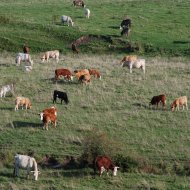Tennessee cow to receive prosthetic hoof

Dudley had been living uncomfortably for months on a cattle ranch in Tennessee.
A cow suffering from horrific hoof injuries has undergone successful surgery to amputate damaged tissue and bone in preparation for a prosthetic leg.
The cow, who has been named Dudley, had been living on a cattle ranch in Tennessee. Sadly, whilst on the ranch, a ball of bailing twine wrapped around his foot, constricting the blood flow and eventually causing his foot to fall off. Luckily, the rancher took pity on Dudley and he was spared slaughter.
Although the rancher gave Dudley antibiotics to heal the infections, he did not have the money available to give Dudley further care. Dudley spent the next 10 months having a difficult time standing or walking. Because he was limping, his spine became out of alignment, his muscles wasted away and he was in constant pain.
The cow was brought to the attention of animal welfare organisation, The Gentle Barn and the organisation immediately started calling veterinary hospitals and companies who manufactured prosthetics.
After tests carried out by an expert in bovine care and surgery at the University of Tennessee, Dudley was confirmed as an excellent candidate for a prosthetic limb.
Dudley was taken to surgery last Wednesday (21 January). Dr. Anderson from the University of Tennessee amputated the damaged tissue and bone, and sutured him up. Dr. Anderson then made a mould of Dudley's leg, which was sent to the prosthetic company to be used to create the permanent prosthesis. It is expected that this will be ready in about a month.
According to the organisation's Facebook page, Dudley is now wearing a temporary prosthetic and is making a great recovery. He is putting weight on the leg and is allowing doctors to handle him with little resistance.
The Gentle Barn hope that, all going well, Dudley will soon start physical therapy.



 The RCVS has announced a new version of its 1CPD mobile app, with enhanced features for veterinary surgeons and veterinary nurses to record their continuing professional development.
The RCVS has announced a new version of its 1CPD mobile app, with enhanced features for veterinary surgeons and veterinary nurses to record their continuing professional development.